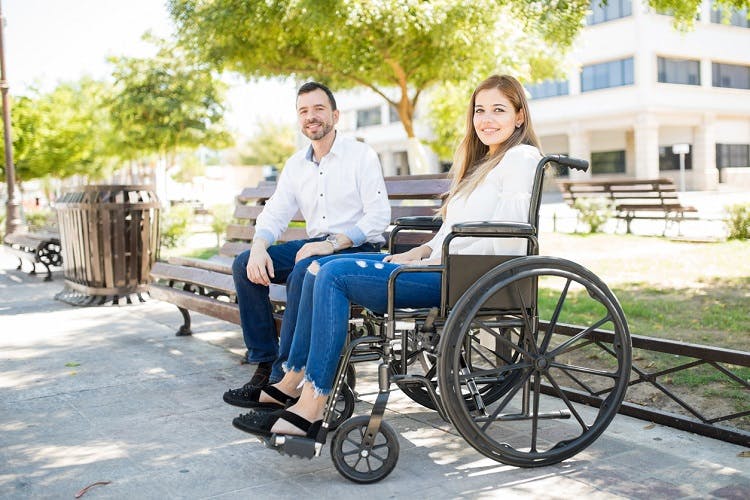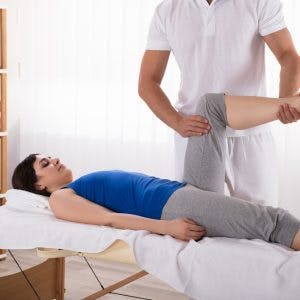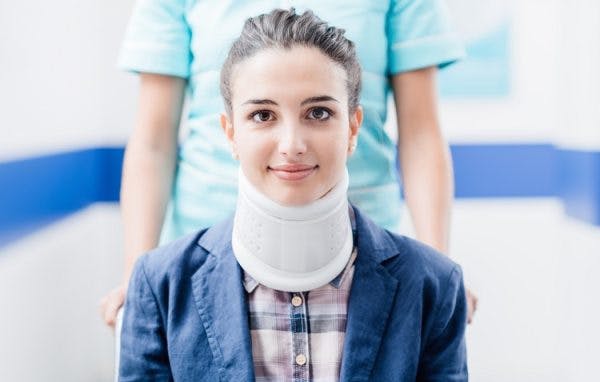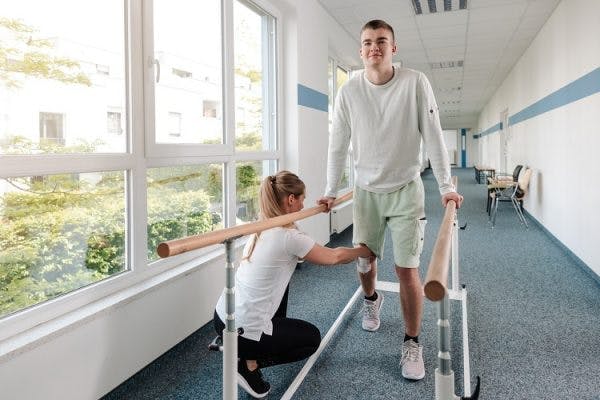Incomplete quadriplegia involves weakness or paralysis of all four limbs. Depending on the severity of the spinal cord injury, individuals may have residual movement.
About 47% of all spinal cord injuries result in incomplete quadriplegia, making it the most common type of spinal cord injury. Many individuals with incomplete quadriplegia learn to effectively manage and improve their sensory and motor impairments to improve their quality of life.
To help you understand what to expect and how to cope, this article will answer some of the most frequently asked questions about incomplete quadriplegia, including:
- What’s the difference between tetraplegia and quadriplegia?
- What causes incomplete quadriplegia?
- What’s the difference between complete and incomplete quadriplegia?
- Is it possible for complete quadriplegia to turn into incomplete quadriplegia?
- What are some realistic recovery goals for incomplete quadriplegia?
- Can incomplete quadriplegia be treated?
- Should individuals with incomplete quadriplegia exercise?
What’s the Difference Between Tetraplegia and Quadriplegia?
Tetraplegia and quadriplegia refer to the same condition and can be used interchangeably. The roots ‘quadri’ (Latin) and ‘tetra’ (Greek) both mean ‘four’ and ‘plegia’ means ‘paralysis’. Combined, the terms refer to paralysis of all four limbs.
In individuals with spinal cord injuries, quadriplegia also includes paralysis of the trunk. This is because the areas of the spinal cord that innervate (supply energy to) the arms are located above the areas that innervate the trunk and legs. Signals from the brain cannot pass through damaged areas of the spinal cord and as a result, cannot reach areas below the level of injury.
Additionally, in those with spinal cord injuries, sensory signals from the body are also unable to pass through damaged areas of the spinal cord to reach the brain. Therefore, individuals with quadriplegia due to SCI frequently experience a loss of sensation in their arms, trunk, and legs.
Depending on the level and severity of your spinal cord injury, quadriplegia can take on many forms. For example, some individuals might have normal arm functions and weakness in the hands while others can be paralyzed from the neck down. While functional outcomes vary significantly, medical professionals classify both conditions as quadriplegia.
What Causes Incomplete Quadriplegia?

Incomplete quadriplegia is caused by damage to the cervical spinal cord, which is the uppermost region of the spinal cord located around the neck. Both motor and sensory nerves branch off from the cervical spinal cord, innervating the neck, shoulders, arms, and hands.
The most common causes of incomplete quadriplegia include car collisions, sports accidents, falls, and violence.
A higher level of injury can affect more areas of the body. This occurs because messages to and from the brain cannot get past the spinal cord damage. As a result, the injury affects all functions below its level.
For example, a C2 spinal cord injury can affect all functions from the neck down while an L1 SCI can only affect lower body functions. All functions associated with levels above the spinal cord injury will be normal.
What’s the Difference Between Complete and Incomplete Quadriplegia?
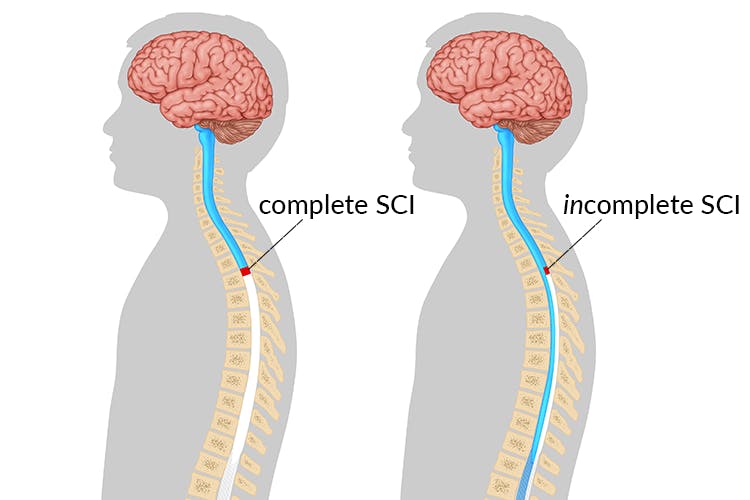
Complete and incomplete quadriplegia refers to the severity of one’s spinal cord injury. Often, a CT scan or MRI is used to determine whether the injury is complete or incomplete.
When an SCI is incomplete, it means that there is only partial damage to the spinal cord and some connections between the brain and areas below the level of injury still exist. Spared neural connections play an essential role in recovery because they’re capable of utilizing neuroplasticity, the central nervous system’s ability to rewire itself. As a result, individuals with incomplete quadriplegia can stimulate spared connections to promote neural adaptations and relearn affected functions.
However, incomplete quadriplegia can manifest itself differently in each individual. Some have milder lesions and may be able to move and feel areas below their level of injury while others have more severe ones. As long as some neural connections exist, a spinal cord injury is considered incomplete.
In contrast, a complete spinal cord injury results in no spared neural pathways at the level of injury. As a result, there is no way for nerve impulses carrying messages to and from the brain to travel past the level of injury. Therefore, those with a complete spinal cord injury will not have any motor or sensory functions below their level of injury because all connections at the site of injury have been damaged.
Because damaged pathways are not capable of regeneration, there is limited recovery outlook for lost functions. Instead, rehabilitation for complete quadriplegia focuses on maximizing the potential of unaffected functions, compensating for lost functions, and preventing further complications below the level of injury.
Is it Possible for Complete Quadriplegia to Transition into Incomplete Quadriplegia?
Damaged neurons in the central nervous system are not capable of regenerating. As a result, physical damage to the spinal cord is permanent. While complete quadriplegia cannot turn into incomplete quadriplegia, it is possible to mistake an incomplete SCI for a complete one.
Immediately after a spinal cord injury, swelling of the spinal cord can restrict blood flow and cause spinal shock. Spinal shock refers to the complete loss of motor control and reflexes below your level of injury.
Fortunately, it is a temporary condition and functions can gradually start to return as swelling dies down. Spinal shock can last anywhere from a few days to several months, so many individuals with spinal cord injuries may be surprised to find out that their injury isn’t as severe as it initially appeared.
What Are Realistic Recovery Goals for Individuals with Incomplete Quadriplegia?
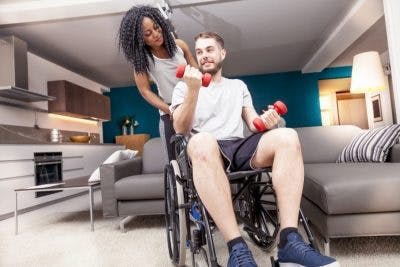
Often, those with incomplete quadriplegia will participate in physical and occupational therapy. Physical therapy for incomplete quadriplegia focuses on maximizing mobility through stretching, range of motion, and strengthening exercises. Physical therapy may also assist with increasing sitting and standing balance and recommending appropriate equipment for mobility (platform walkers, standard walkers, etc), as well as training specific muscle groups for mobility.
On the other hand, occupational therapy addresses ways to increase an individual’s level of independence with basic daily living skills, such as dressing, bathing, and toileting. They may also help patients to regain independence in higher-level skills, such as cooking, driving and returning to work. Occupational therapy may utilize splinting, sensory re-education, rehabilitative exercises, and adaptive strategies and equipment to address individuals’ goals.
To maximize independence, individuals with incomplete quadriplegia will generally focus on improving upper extremity functions before lower extremity functions. However, the ultimate goal is to maximize overall mobility and any sort of movement is encouraged.
Many individuals with spinal cord injuries recover functions from at least 1-2 levels below their level of injury with consistent participation in physiotherapy. However, every spinal cord injury is different, and even amongst individuals with the same level and severity of injury, recovery outcomes will vary. Therefore, it’s essential to work with physical and occupational therapy and get a personalized rehabilitation plan.
Recovery Goals for Individuals With Incomplete Quadriplegia
Breaking up your main goal into smaller, more specific goals can help make recovery more assessable and keep you motivated. It’s important to remember that individuals with a higher level of injury will likely have more functional difficulties initially, but can make great progress over time. Goals vary greatly depending on the level and severity of the injury.
Below are some recovery goals a person with incomplete quadriplegia may set:
- Improving breathing control
- Strengthening cough
- Raising the arms
- Bending and extending the elbow
- Rotating the wrist
- Grasping objects
- Getting dressed independently
- Reaching without losing balance
- Sitting upright without support
- Transferring independently
- Regaining bowel and bladder control
- Bending and extending the knees
- Rotating the ankles
- Seated marches
- Standing
- Walking
- Returning to work
- Driving
Because individuals with incomplete spinal cord injuries may be able to recover affected functions, working with physical and occupational therapists to maximize mobility and independence is ideal.
Is There a Treatment for Incomplete Quadriplegia?
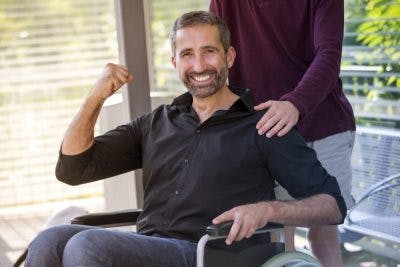
While there isn’t a “cure-all” treatment for incomplete quadriplegia, individuals have the potential to improve their mobility and recover affected functions.
In the following sections, we’ll discuss some of the leading methods for recovering mobility after a spinal cord injury:
Epidural Stimulation
Epidural stimulation is a promising alternative to traditional spinal cord injury treatment. It involves implanting a stimulator to the lower spine that sends electrical currents to areas below the level of injury.
Rather than healing spinal cord damage, epidural stimulation works around the injury. The electrical currents mimic brain signals and excite the neurons, enabling movement below one’s level of injury.
In this electrical stimulation study, a participant with C5 incomplete quadriplegia achieved overground walking with the help of assistive devices over 85 weeks. He was also able to stand using a walker and sit independently with the stimulator on.
Stem Cell Therapy
Another promising therapy for individuals with incomplete quadriplegia is the use of stem cells.
Stem cells have 2 properties that make them ideal for healing:
- They can divide infinitely: Stem cells can divide and renew themselves for long periods. Theoretically, this can help replenish cells after a spinal cord injury.
- They are unspecialized: Stem cells are extremely versatile and can differentiate into various cell types depending on their surrounding environment.
The problem with stem cell therapy for spinal cord injury is that neurons in the spinal cord don’t regenerate as simply as other cells in the body. Unlike epidural stimulation, stem cell therapy aims to replace damaged neurons in the spinal cord and promote better communication between the brain and lower spinal levels.
While stem cell therapy is still being researched, study participants with incomplete quadriplegia have shown improvements in recovering motor function.
Exercise
Both epidural electrical stimulation and stem cell therapy require intensive physical training.
After a spinal cord injury, you must relearn how to move your body through massed practice. The more frequently you repeat a movement, the better your central nervous system gets at recognizing and strengthening the neural pathways for it. As a result, the easier that movement will become. Integrating a movement into a regular daily activity, such as using your arm to reach into an overhead cupboard, can also help your brain to relearn this motion more quickly
Because people with incomplete quadriplegia still have some spared connections between the brain and areas below the level of injury, repetitive exercise can encourage those connections to adapt and learn new functions. Every movement you make stimulates the spinal cord and consistent training can help promote neuroplasticity.
Want 15 pages of SCI recovery exercises in PDF form? Click here to download our free SCI Rehab Exercise ebook now (link opens a pop up for uninterrupted reading)
Should Individuals with Incomplete Quadriplegia Exercise?

Even if you have extremely limited movement after a spinal cord injury, exercise is essential to promote circulation, improve range of motion, and prevent further complications.
If you can’t move very much on your own, consider passive range of motion exercises. Passive range of motion exercises do not require you to exert energy. Instead, a physical or occupational therapist or trained caregiver moves your body for you. While you won’t be the one performing the movements, you should actively focus on them and picture yourself doing them independently. This can help increase cortical excitability in the brain and promote neuroplasticity.
By moving the joints through their entire available range of motion, as recommended by your therapist, individuals can minimize stiffness, promote circulation, prevent unnecessary pain, and limit the likelihood of developing pressure ulcers.
Remember, individuals with incomplete quadriplegia have the potential to improve. However, you must put in the effort and move your body as much as you can to stimulate neurological adaptations in the central nervous system.
Understanding Incomplete Quadriplegia
Thanks to spared neural pathways, individuals with incomplete quadriplegia can potentially recover functions affected by spinal cord injury.
Many factors including the severity and level of injury, intensity of rehabilitation, motivation, and co-occurring health complications can impact recovery. By actively participating in rehabilitative therapies, practicing exercises at home, and properly managing secondary complications, individuals can significantly improve their quality of life.
We hope this article helped you understand what incomplete quadriplegia is and how to improve your mobility and independence.

